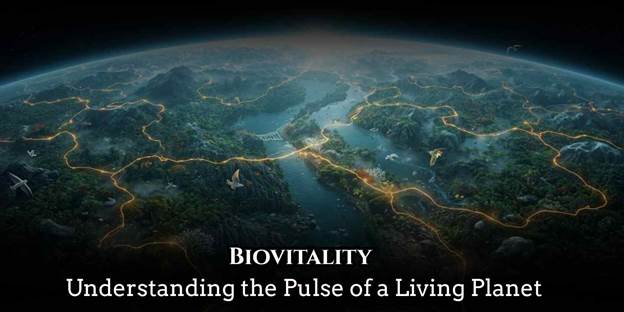The concept of Biovitality captures the very heartbeat of our living planet the measure of how alive, adaptive, and balanced Earth’s ecosystems truly are. Every forest, ocean, and wetland contributes to this intricate web of vitality that sustains all life. As climate change accelerates and biodiversity declines, understanding Biovitality has become more crucial than ever.
This article explores what Biovitality means, its relationship with ecosystem resilience, why it matters for our planet’s future, and how humans can protect and enhance it through sustainable practices. Together, these insights offer a deeper appreciation of Earth’s living pulse and our responsibility to maintain it.

1. Biovitality Explained: The Hidden Energy of Life
At its core, Biovitality refers to the dynamic strength, diversity, and regenerative power that define living systems. It’s not just about the number of species but how they interact, adapt, and sustain balance within ecosystems.
In simple terms, Biovitality is the biological vitality of nature the measure of how healthy and functional ecosystems are. It reflects how well organisms respond to environmental stressors, recover from disturbances, and continue to support life.
Biovitality thrives where ecosystem vitality and biological diversity are high. For instance, coral reefs and tropical rainforests show immense Biovitality because they host complex life networks, from microorganisms to apex predators, all contributing to the system’s self-sustaining balance.
2. The Evolution of Biovitality in Earth’s History
The story of Biovitality stretches back billions of years, starting with the first microbial mats that oxygenated the planet. Through mass extinctions, glaciations, and evolutionary leaps, life has constantly regenerated, proving that resilience is nature’s ultimate trait.
During each major recovery from the Permian extinction to today’s Anthropocene Biovitality has demonstrated its capacity to rebound through biodiversity and adaptation. This ongoing regeneration illustrates the deep link between Biovitality and the planet’s ecosystem resilience the ability of natural systems to withstand shocks and recover from them.
3. Why Biovitality Matters for Planetary Health
Healthy Biovitality equals a healthy planet. When Biovitality is strong, ecosystems maintain balance, regulate climate, and provide essential services like clean air, fertile soil, and freshwater.
Here’s why it matters:
- Regulation of Climate: Forests with high Biovitality act as carbon sinks, helping mitigate climate change.
- Biodiversity Support: High Biovitality means a greater range of species and stronger food webs.
- Sustainable Resources: Ecosystems with robust Biovitality provide renewable resources for human survival.
The decline in Biovitality, often caused by deforestation, pollution, and overexploitation, weakens the planet’s resilience, making it harder for nature to recover from disasters.
Related Article: The Science of Biovitality: Measuring Life Energy to Promote Environmental Sustainability
4. The Symbiotic Link Between Biovitality and Ecosystem Resilience
Biovitality and ecosystem resilience are interdependent forces. Biovitality ensures diversity and adaptability, while resilience ensures endurance and recovery.
When ecosystems lose Biovitality, their capacity for resilience diminishes. For example:
- Coral bleaching events reduce Biovitality, making reefs more vulnerable to temperature changes.
- Deforested regions lose soil fertility, reducing ecosystem resilience against erosion and drought.
This synergy shows that nurturing Biovitality strengthens resilience, ensuring long-term planetary stability.
5. Real-World Examples of Biovitality in Action
Examples of strong Biovitality exist worldwide, showing how ecosystems can recover and thrive when given a chance:
- The Amazon Rainforest: Despite pressures, its incredible biodiversity and interconnected systems represent one of the highest forms of Biovitality on Earth.
- The Great Barrier Reef: Conservation efforts are helping to restore coral Biovitality by reducing pollution and protecting marine species.
- Rewilding Projects in Europe: By reintroducing wolves and restoring natural habitats, Europe is witnessing the return of ecological balance and renewed Biovitality.
These examples prove that when humans act as stewards, nature’s innate Biovitality can regenerate itself impressively.

6. Challenges Threatening Global Biovitality
Despite its strength, Biovitality faces unprecedented challenges. Human-driven activities have pushed natural systems beyond safe limits.
Key threats include:
- Climate Change: Rising temperatures disrupt species balance and reduce ecosystem vitality.
- Deforestation: Habitat loss destroys the natural fabric of Biovitality.
- Pollution: Contaminants degrade soil and water systems, harming biological diversity.
- Overexploitation: Overfishing, mining, and unsustainable agriculture deplete resources faster than nature can replenish them.
Without urgent action, the decline in Biovitality could lead to ecosystem collapse and irreversible biodiversity loss.
7. Strengthening Biovitality Through Sustainable Action
Protecting and enhancing Biovitality requires integrated, science-backed efforts. Individuals, communities, and governments can all contribute:
- Reforestation and Habitat Restoration: Rebuilding natural areas enhances Biovitality and carbon capture.
- Sustainable Agriculture: Organic farming preserves soil ecosystem vitality and prevents degradation.
- Biodiversity Protection: Safeguarding endangered species sustains the natural balance essential to Biovitality.
- Eco-conscious Policies: Enforcing conservation laws strengthens global Biovitality and ecosystem resilience.
Empowering local communities to participate in conservation ensures that Biovitality remains rooted in human responsibility and environmental stewardship.
Conclusion: Biovitality The Pulse We Must Protect
In essence, Biovitality represents the heartbeat of Earth’s ecosystems the measure of how alive and resilient our planet truly is. Strengthening Biovitality enhances biodiversity, stabilizes climate systems, and secures the natural resources future generations depend upon. To preserve the Biovitality of our world, we must commit to sustainable living, protect natural habitats, and restore balance to the living web of life. The pulse of the planet depends on our collective care let’s keep it strong.
Pingback: The Science of Biovitality: Measuring Life Energy to Promote Environmental Sustainability - Regarding Planet